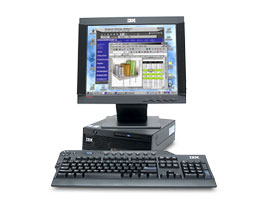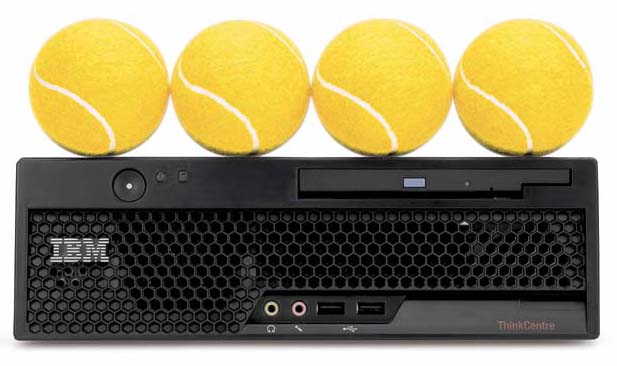IBM ThinkCentre S50 / A50 'IBM mini'
System Type: 8086, 8087, 8088, 8089, 8090, 8094

Model: A50 | Corresponding System Type: 8089, 8090
Model: A51 | Corresponding System Type: 8105, 8107, 8109, 8117, 8120, 8121
Model: M51 | Corresponding System Type: 8104, 8106, 8108, 8118
Model: S50 | Corresponding System Type: 8086, 8087, 8088, 8094
Model: M55 | Corresponding System Type: 6489, 8009, 8791, 8795, 8799, 8803, 8807, 8812 | Note these are the later minis made by lenovo
First released in 2004, these machines are an "Ultra Small Form Factor" (USFF) desktop PC. Surprisingly these systems have escaped LGA 775 and instead use socket 478; which allows a high performance Northwood to be installed (although that the expense of some instruction sets present on Prescott that may cause a performance hit on certain things). DDR1 (400 Mhz) is also used instead of DDR2; which is actually beneficial as early iterations of DDR2 had latency issues, so you'll get a much faster outcome with low-latency DDR400 memory modules.
Manuals
--> Hardware Maintenance Manual
--> User Guide
--> Quick Reference
Downloads / Drivers
--> Latest BIOS .ISO (ONLY FOR 8086, 8087, 8088, 8089, 8090, 8094)
--> Intel Video Driver (W2K through XP - ONLY FOR 8086, 8087, 8088, 8089, 8090, 8094)
--> Soundmax Audio Driver (W2K through XP - ONLY FOR 8086, 8087, 8088, 8089, 8090, 8094)
These ThinkCentres are some of the least common of the period as most were simply the Small Form Factor variants (which allowed larger heatsinks for the hotter LGA775 Prescotts, and also a bay for floppy diskettes in businesses that needed the legacy support). Developed by IBM Japan for space conservation, they were popular for situations where only a very tiny desktop could fit, but without compromise to the machine itself; requiring that an integrated PSU, full length PCI, and all standard features are still present. Like the IBM T221 which was also developed heavily by IBM Japan, these never saw as much popularity outside of Japan.

To make matters confusing with the naming scheme, these miniature ThinkCentres can be referred to as 'A50' or 'S50'-- however there are larger counterparts under the same model-- like the A50p towers for instance. As such, it's easier to just find or categorize them by their system type: of which they're the only IBMs to use the system type '8086' or '8088' (which of course everyone knows refers to the early Intel CPUs-- entirely coincidental but humorous).
As usual in IBM fashion, the risercard was chosen over a half-height vertical slot for more practicality (most OEMs will cheap out and won't use a risercard for proper full length cards).
The power supply design is not too dissimilar to designs found in the PS/2 Model 56 and Model 80, as well as the tool-less aspects.
To get the best performance from these machines, install 2 GB of low latency DDR400, and a 3.2 Ghz Northwood (go with the Prescott if you need youtube and other things of that nature-- the Prescotts also run a lot more cool). The IBM documentation does not list a 3.4 Ghz Northwood, so I cannot guarantee the PSU or VRM can handle it. If it's like the IntelliStation M Pro 9229, it could potentially fail to power up with the fastest CPU on the platform (9229s will fail to power up after awhile with the QX6800).
Design Features
There's a few notable design aspects about these systems. First and formost the heatsink is the most copper-laden heatsink I have ever seen. It uses a copper slab over an INCH thick. Next up would be the modular fan holders-- very similar to the system x3300 fan holders.
The system weighs almost 15 pounds-- making it one of-- if not-- the heaviest computer for its size ratio ever manufactured.
It may also be the smallest computer of its size to feature a *full length* PCI slot.
Faster Motherboard?
For those who really like the idea of the IBM mini-- and would love to own one-- but are turned off from the earlier Pentium 4 CPUs, Lenovo did release a newer motherboard for these systems that you might be able to swap into your existing (older) IBM mini, or just buy the newer mini outright.
The system type for the [last] IBM mini models ever made is type 8807. These systems can support Core 2 Duo CPUs-- so they'll be a consdierably boost in performance and far more efficient if you want a better CPU for you IBM mini. I do not believe the 8807 boards are a drop-in replacement for the earlier Northwood IBM minis-- as IBM changed the bracket style. I could be wrong, never tried it. On a positive note if you want that IBM logo, you should be able to effortlessly pop on an IBM bezel.
PS/2E vs. the IBM mini
How well does the IBM mini compare in contrast to the PS/2E? Well here's a comparsion:
PS/2E
Weight: ?
Power Consumption: 24 watts
Dimensions: ?
Slot(s): one
Uses ThinkPad drive: yes (1.44 MB FDD)
IBM mini
Weight: 14 - 15 lbs
Power Consumption: 200 watts
Dimensions: ?
Slot(s): one
Uses ThinkPad drive: yes (CD-ROM / DVD in later minis)
The PS/2E is considerably smaller in height, but considerably larger in depth and width. It uses FAR less power, but of course having a super-powered 386SX means that the performance-per-watt might be lower. Although considering how inefficient netburst is, the IBM blue lightning in the PS2/E might hilariously be more efficient for what it is.

